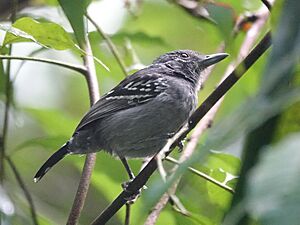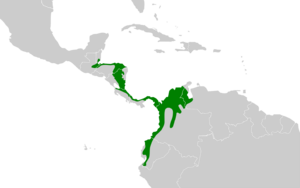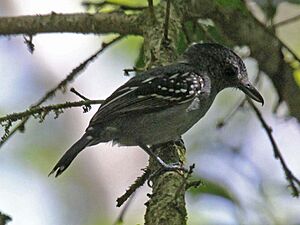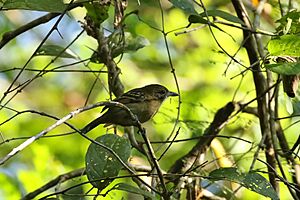Black-crowned antshrike facts for kids
The black-crowned antshrike is a fascinating bird that lives in the forests of Central and South America. It belongs to a family of birds called "typical antbirds." You can find this bird in many countries, including most of Central America, Colombia, Ecuador, Peru, and Venezuela.
Quick facts for kids Black-crowned antshrike |
|
|---|---|
 |
|
| Conservation status | |
| Scientific classification | |
 |
|
| Synonyms | |
|
Thamnophilus punctatus atrinucha |
Contents
About the Black-crowned Antshrike's Name
For a long time, the black-crowned antshrike was thought to be just a type of another bird called the "slaty antshrike." But in 1997, scientists did more research. They discovered that the slaty antshrike was actually six different species! The bird we now call the black-crowned antshrike became its own species.
Later, around 2012, experts realized this bird wasn't closely related to the other "slaty antshrikes" at all. So, its English name was officially changed to the black-crowned antshrike. It has two slightly different types, called subspecies. One is found in many places, and the other lives only on a special island.
What Does the Black-crowned Antshrike Look Like?
The black-crowned antshrike is about 14 to 15 centimeters (5.5 to 6 inches) long. It weighs between 20 and 28.5 grams (0.7 to 1 ounce). Like other antshrikes, it has a strong bill with a hook at the end, similar to a shrike bird.
Males and females of this species look quite different. This is called sexual dimorphism.
- Males usually have a slaty gray body. Their forehead is gray, but their crown (the top of their head) and the back of their neck are black. They have a hidden white patch on their back. Their wings are black with white tips, and their tail is black with a small white spot on each feather.
- Females have brown to buffy brown upper parts. Their wings are dark with brown edges and white tips. Their underside is buffy brown to grayish brown.
Both sexes have brownish-red eyes and dark gray legs and feet. Males have a dark gray bill, while females have a lighter gray bill. Young birds are dull cinnamon-brown on top and grayish-white underneath.
Where Do Black-crowned Antshrikes Live?
The black-crowned antshrike lives in many parts of Central and South America.
In Central America, you can find it from southern Belize all the way through Panama. It also lives on the Pacific coast of Costa Rica and Panama. In South America, it's found across northern Colombia and northwestern Venezuela. It also lives along the Pacific coast of Colombia and Ecuador, reaching into far northwestern Peru.
A special subspecies lives only on Gorgona Island, off the coast of Colombia.
These birds like to live in different kinds of forests. They prefer the inside of the forest but can also be seen at the edges. They usually stay in the lower and middle parts of the trees, but sometimes they go all the way up to the top. They can live from sea level up to about 1,500 meters (4,900 feet) high, depending on the country.
Black-crowned Antshrike Behavior
How They Move
Black-crowned antshrikes stay in the same area all year round. They do not migrate.
What They Eat
These birds eat a lot of different insects and other small creatures like spiders. They have even been seen catching small lizards! They usually look for food alone or in pairs. They often join groups of different bird species that are feeding together.
They mostly search for food in the lower and middle parts of the trees, but sometimes they go higher. They are very careful when they hunt. They pick prey off leaves, branches, and moss. They might also fly out to catch insects in the air or flip over leaves on the ground to find food. Sometimes, they follow swarms of army ants to catch insects that are trying to escape the ants.
How They Raise Their Young
The breeding season for black-crowned antshrikes changes depending on where they live and the year. It's usually busiest between April and July.
Their nest is shaped like a cup. It's made from things like moss, roots, and spider silk. The nest hangs from a branch fork, usually about 2 meters (6.5 feet) above the ground, but sometimes as high as 7 meters (23 feet).
A female usually lays two eggs. Both parents take turns sitting on the eggs to keep them warm. This "incubation" period lasts about 14 to 16 days. After the chicks hatch, they stay in the nest for about 10 days before they are ready to fly. Both parents bring food to the baby birds.
Their Songs and Calls
The black-crowned antshrike has a very clear song. It sounds like a series of "uh" notes that end with a single "erk" sound, which is higher pitched. Both male and female birds sing, often in the morning, but they can sing at any time of day.
They also make different calls, like a "caw" sound that can have one to four notes, often two, sounding like "arr-arr." They also have a "bark-rattle" call that sounds like "arr-grr'r'r'r."
Conservation Status
The black-crowned antshrike is listed as a species of "Least Concern" by the IUCN. This means that it is not currently considered to be in danger of extinction.
It lives in a very large area, and even though we don't know the exact number of birds, their population seems to be stable. There are no major threats to this bird right now. It is quite common in the places where it lives.
Even though it's doing well, scientists note that these birds prefer to stay within forests. They don't like to cross open areas. This could make them more vulnerable if their forest homes are cut down or broken up into smaller pieces.




